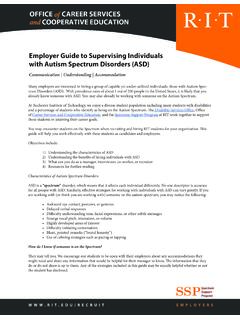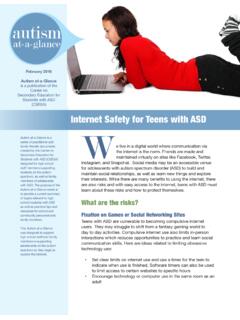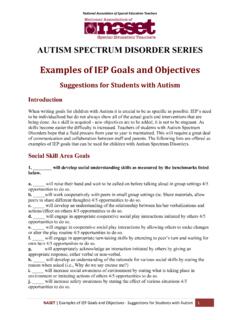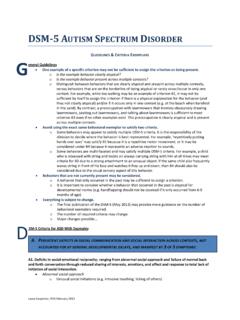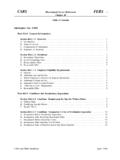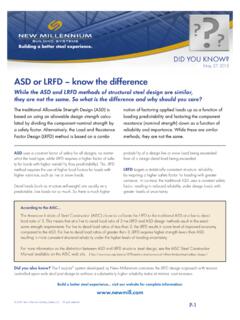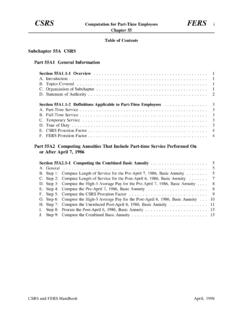Transcription of EMOTION REGULATION IN ASD - ECHO Autism
1 P a g e 1 o f 6 All rights reserved - Susan White, Caitlin Conner, Kelly Beck, & Carla Mazefsky; & EMOTION REGULATION IN ASD What is EMOTION REGULATION ? Processes that we use to modify emotional reactions. We can be aware or these processes or not, purposefully trying to do them or not. In other words, sometimes it takes effort to manage EMOTION . EMOTION REGULATION problems are common in people with Autism spectrum disorder (ASD). EMOTION REGULATION problems can be associated with symptoms of depression, anxiety, behaviors such as aggression or self-injury, and social difficulties, both in people with ASD and without ASD. How do problems with EMOTION REGULATION show up in ASD? Issues with recognizing emotions in one s self Overuse of more maladaptive EMOTION REGULATION strategies, like rumination ( , continuing to think about a distressing situation long after it is over), shutting down, avoidance I go from 0-100 not noticing increase of EMOTION intensity until it s very difficult to respond appropriately Being stuck- like feeling unable to let go of a feeling Meltdowns or being quick to strongly react or, conversely, being withdrawn, lethargic, and sluggish Why are EMOTION REGULATION problems often seen in people with ASD?
2 There is a lot of research happening to answer this question. Right now, our best hypothesis is that there are neurobiological reasons ( , atypical brain connectivity) and heightened sensitivity to the experience of emotions . Common characteristics that are part of having ASD, may increase risk for EMOTION REGULATION difficulties (see Figure 1 for some examples). EMOTION Dysregulation in ASDA lexithymia, Limited emotional languageCognitive rigidity; Poor flexibilityLower inhibitionPoor problem-solving & abstract reasoningDifficulty reading social & emotional cuesSensitivity to change & environmental stimulationBiological predisposition (physiological arousal, neural circuitry, genetics)Fig. 1. Characteristics of ASD that may contribute to EMOTION dysregulation. From Mazefsky, , & White, (2014).
3 EMOTION REGULATION : concepts and practice in Autism spectrum disorder. Child Adolescent Psychiatric Clinics of North America, 23 (1), 15- 24. P a g e 2 o f 6 All rights reserved - Susan White, Caitlin Conner, Kelly Beck, & Carla Mazefsky; & MELTDOWNS IN ASD Meltdowns and how to avoid them: Meltdowns occur when a person is totally overwhelmed and can become out of control of his or her actions. Can scream, cry, kick, lash out, bite, engage in self-injury, run away Not a temper tantrum! This is not the same as misbehaving, which often has a goal (like avoiding a command) Identify triggers maybe you identify particular times, places, or activities that are likely to precipitate distress. Ask the person if they know when they are about to have a meltdown. Can the person offer suggestions on how you can help?
4 Are there signs you can look out for? Can they signal to you? Try in general to minimize known triggers, like overwhelming sensory environments and changes in routine. However, total avoidance is not suggested as that will prevent learning adaptive strategies. Prep the individual ahead of time, including reminding them of one or two simple strategies to try. How to respond when meltdowns occur: Try to redirect attention early if you notice any warning signs; Can redirect to calming activities: a preferred activity, fidget toys, listening to calming music, deep breaths Reduce environmental stimuli turn off music/TV, turn off overhead lights, clear out other people Give them space and time Develop a way to cue the person to use calming strategies (a verbal cue, a coping card ) Acknowledge the feeling and model an accepting mindset about EMOTION - that having emotions is normal, even when the feelings are not positive.
5 Use the person s name when talking and use simple statements Remain calm and monitor your voice volume Simplify the task ( this seems really hard; let s do it one step at a time ); Collaborative attitude let s solve this problem together Maintain warm, neutral acceptance he/she is doing the best they can with the tools they currently have Remember that the person may be continuing to process the situation, or may remain on high alert, long after the meltdown has ended; proceed slowly when re-engaging. How NOT to respond during a meltdown: Do not ask a lot of questions Do not ask how he/she is feeling or why he/she is feeling this way. But, you can help them understand by acknowledging their distress ( I see you are upset ). Do not tell the person he/she needs to calm down, relax, or just breathe ; Even typically developing individuals can rarely calm down on command and such statements can escalate the situation and frustrate all parties involved.
6 Instead, try modeling calming strategies ( let s breathe together ). Do not demand eye contact during a meltdown. Do not try to talk him/her out of a repetitive behavior/routine as sometimes familiar rituals can serve a calming purpose or restore a sense of self-control. Avoid getting into a debate. Avoid placing additional demands or insisting on difficult tasks during clear signs of increasing distress Be careful about letting meltdowns or behavior lead to getting out of nonpreferred activities or the behavior can become a learned response ( , re-introduce the task at a later time, with supports) P a g e 3 o f 6 All rights reserved - Susan White, Caitlin Conner, Kelly Beck, & Carla Mazefsky; & THERAPY with CLIENTS with ASD Tips for therapists treating EMOTION REGULATION problems in a client with ASD: Have an open and accepting attitude!
7 Most individuals with ASD and extreme EMOTION dysregulation want the situation to be better. Be confident most often what works outside of ASD is worth trying with clients with ASD, with some modifications so use what you know works well Use concrete, straightforward statements and questions Use visuals to support learning Avoid over-questioning; make sure you allow long pauses for clients with processing difficulties Offer discrete choices if client has difficulty with open ended inquiry Encourage the client to communicate back their understanding of concepts/problems Consider more repetition and more practice of skills to increase generalization Parent/guardian can often be extremely useful to engage in treatment, to aid communication and ensure use of strategies at home Be aware of common cognitive challenges that may need to be considered and addressed.
8 For example, black-and-white thinking tendencies could lead clients to think there is a single way to do things, or to have misconceptions about therapy ( , go to therapy for the therapist to fix the problem). Do not assume a client is being defiant, resistant, or oppositional; although this sometimes occurs, it is most often the case that there is an underlying skill deficit or lack of understanding that the client may not be able to effectively communicate Are there research supported approaches for treating EMOTION REGULATION impairment in ASD? Cognitive-behavioral therapy (CBT) is considered evidence-based for use in ASD, for the treatment of anxiety. It involves changing the content of thoughts to decrease negative EMOTION . Strategies often utilized include problem-solving, exposure, and cognitive restructuring or reappraisal (thinking about a situation in a different way) o Has been studied most for anxiety in ASD; less is known about how it impacts EMOTION REGULATION generally or other problems like depression and aggression o CBT is also commonly used outside of ASD and the majority of psychologists and counselors will have training in this approach Functional Behavioral Assessment (FBA) is considered evidence-based for use in ASD, for determination of causes and maintaining factors of problem behavior.
9 It is focused on identifying the antecedents (what happens before the behavior), the behavior (what does the reaction look like?), and consequences (what happens after the behavior) o FBA can be especially useful for identifying triggers to intense emotions or responses that may be sustaining negative reactions o FBA is time-intensive and is best when completed by an appropriately trained professional ( , behavioral psychologist or BCBA) Mindfulness-based intervention (MBI) is an emerging treatment, meaning there is some research that suggests it is helpful, but not enough to consider it evidence-based . MBI teaches a person to be more internally aware, of sensations, feelings, and thoughts. It is present-focused and emphasizes that EMOTION is natural and unavoidable. o Emerging research in ASD suggests that MBI can help with symptoms of depression and anxiety, hostility/anger, and managing emotions in the moment.
10 O Examples of MBI s include Dialectical Behavior Therapy and Mindfulness-Based Stress Reduction P a g e 4 o f 6 All rights reserved - Susan White, Caitlin Conner, Kelly Beck, & Carla Mazefsky; & THE EMOTION AWARENESS AND SKILLS ENHANCEMENT PROGRAM What is the EMOTION Awareness and Skills Enhancement (EASE) Program? The EASE program is a 16-week MBI, individual therapy treatment designed to improve EMOTION REGULATION in adolescents and adults with ASD. The EASE manual was developed based on theory and research, and with input from adults with ASD, therapists, and parents of children with ASD. EASE was piloted in a two-site open trial with 20 participants with ASD (12-17 years old, confirmed ASD diagnosis, IQ> 80). A randomized controlled trial, involving a comparison of EASE to individualized supportive therapy, is currently recruiting new subjects at the University of Pittsburgh (1-866-647-3436 or and at the University of Alabama (205-348-6551 or A pilot trial of a version for EASE for adolescents and adults with ASD and co-occurring intellectual disability (nonverbal IQ above 50) is underway at the University of Pittsburgh (1-866-647-3436 or Model Behind the EASE Program: Concepts emphasized in the EMOTION Awareness and Skills Enhancement (EASE) Program: Help the person understand that emotions are natural and helpful, even bad or uncomfortable emotions .)))
